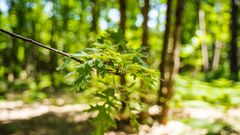Jul 7, 2023
Trees are the best air conditioner!
Learn about urban heat islands, how plants help provide cooling and what you can do to support them.

You’ve probably noticed by the sweat running down your spine: Europe is struggling with the heat. Nothing new under the sun (get it?); it happens every year. Most of South and Central Europe is experiencing extraordinary heat waves, with Greece, Spain and even the Balkans sending out severe weather warnings. But did you know the best air con is all-natural?
Heat islands: not the kind of island where you want to be
Walking down the city streets, you can still feel the heat long after the sun has disappeared behind the roofs. Cities are urban heat islands: the large amounts of stone, concrete, and tarmac absorb and retain the sun’s heat. These same materials don’t let any water go through, so it will simply run down the drain instead of being evaporated, which allows the air to heat up even more.
Our cities’ human activity doesn’t help either: cars, industry and, ironically enough, air conditioning. Yes, air con is actually counterproductive when it comes to fighting the heat in the city, even if it gives you a brief moment of cool relief on a hot summer day.
Air con but with leaves
As is often the case with human-caused issues, the solution can simply be found in nature. Plants have a practically magical ability to provide cooling in different ways:
1. Atmospheric moisture and precipitation
Plants and their environments cause evapotranspiration: water that gets transpired from the leaves and evaporates from the surface water and the soil. Atmospheric moisture not only cools down the earth like a natural AC but also causes precipitation. About 40% of the earth’s rainfall is caused by this process. And what’s better than a good rain shower to make the temperatures bearable again?
2. Trees create shadows
Plants and trees, in particular, create shadows offering a cool spot not only for us but for animals and smaller plants as well. Many crops benefit from growing close to a forest thanks to the shade, the healthy soil and the proximity of animals that help with pollination (insects but also birds, bats and rodents). Forests are great, cool shelters for those animals pollinating the crops that provide us with food. And let’s be honest: when it’s 30 degrees, you probably prefer to sit in the shade under a tree as well.
3. Storage of carbon, a greenhouse gas
This might not be something you’ll notice immediately, but it’s nonetheless essential. Carbon is one of the most dangerous greenhouse gasses causing global warming. Trees, however, capture carbon from the atmosphere and store it in their trunks. They clean the air merely by existing. Isn’t that miraculous?
Of course, trees do need a little bit of care to ensure they’re capable of fulfilling this important role to the best of their ability, so this is where our team of foresters comes in. They protect the trees from diseases and ensure they get all the light and space they need to grow.
What you can do:
Greener cities can help reduce the urban heat island effect. And you can help too!
- Do you have a balcony? Cosy it up with some plants. Put out some potted plants, create your own tiny vertical garden, start a herb garden, or get some small trees.
- Do you have a garden? Switch out the tiles for grass, put a hedge around the garden instead of a stone wall (combined with a fence if you have pets that could sneak out), and plant some bushes, trees and other plants.
- No garden, but you do have a flat roof? Turn it into a green roof!
- No garden or flat roof? Grow a beautiful green facade. Yes, there are climbing plants that don’t damage the walls!
Source: Ellison et al., 2017. Global Environmental Change 43: 51-61
Latest update: 18-07-2024 at 13:19 (CET)










